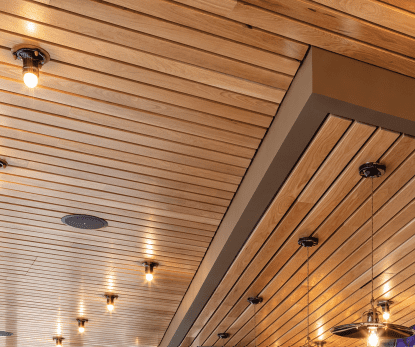Sunlight. Important for photosynthesis, but prolonged exposure can scorch leaves, and the lack thereof can starve a plant. Necessary for Vitamin D but too much or too little can negatively impact a person’s health. As is the case with both plants and humans, the key to UV exposure and wood is consistent moderation.
UV Exposure
If you’ve ever seen an abandoned barn, you’ve seen the result of natural environmental effects on wood, the most damaging of which is UV overexposure. On the surface, colors change from natural to grey or silver, an often desirable look when attempting to achieve a rustic application. Underneath, however, more is happening than meets the eye. If you were to separate the base components of wood, you would find that the organic polymer that fills the cell wall between the fibers (i.e. the glue), is the most sensitive component, absorbing 80-95% of ultraviolet light. When this “glue” breaks down, the cell walls begin to decompose, separate, and lose structural rigidity. This creates the perfect environment for moisture and other environmental parameters to penetrate the surface of the wood, leading to poor durability.
Smaller doses of UV radiation may not cause damage to wood surfaces, but it will change them. This process is called Photodegradation, an “effect on the appearance of exposed wood faces caused by exposure to both sun and artificial light sources” – Architectural Woodworking Standards. Typically, prolonged UV exposure results in a color change to all exposed surfaces. This process, while not 100% avoidable, is manageable through various methods of active UV-blocking materials and passive planning for light exposure.
Combating Ultraviolet Light
First, UV inhibitors or UV absorbers can be added to finishes to dilute or limit the amount of ultraviolet light that can reach the surface of the wood. These finishes are typically referred to as “spar” or “marine” and are usually more expensive than standard finishes due to their UV inhibiting properties. The drawback of using this type of finish is typically color, as the additives will often darken the topcoat color, leaving a less than desirable appearance.
Second, interior applications that sit next to glazing walls can be protected by using UV-blocking glass or protective film. These applications are important because as long as there is glass or film between the wood and the glazing, the glazing will prevent a major source of UV radiation.
Third, architectural planning to prevent inconsistent or unequal UV exposure will allow for a natural, even change in the color and tone of wood. “Shadow lines” are caused by architectural features that cast a persistent shadow over a wall or floor and limit the amount of UV absorption of that section of wood. The result is an uneven exposure followed by an uneven patina or color change. A common example of this is leaving placemats on a table that receives a generous amount of sun. Once removed, discoloration in the rough shape of the placemat remains. In an architectural application, ensuring that sunlight is evenly distributed over the surface of each wood product will promote an even distribution of color change.
Fourth, some wood species are more naturally affected by UV exposure than others. A 2015 study titled “Comparative study of photodegradation of six wood species after short-time UV exposure” looked at six species of wood ( fir, pine, larch, ash, cherry and walnut) exposed to sunlight for different durations of time over a 24-hour period and evaluated changes in redness, yellowness, and lightness. The study found that some species have a more pronounced change when exposed to UV, such as Cherry, and Larch. Choosing a species that is not as affected by UV exposure for high exposure areas can help to limit undesired color change.
To find out more about the best species for the project you’re working on, schedule a design call with our team today!





